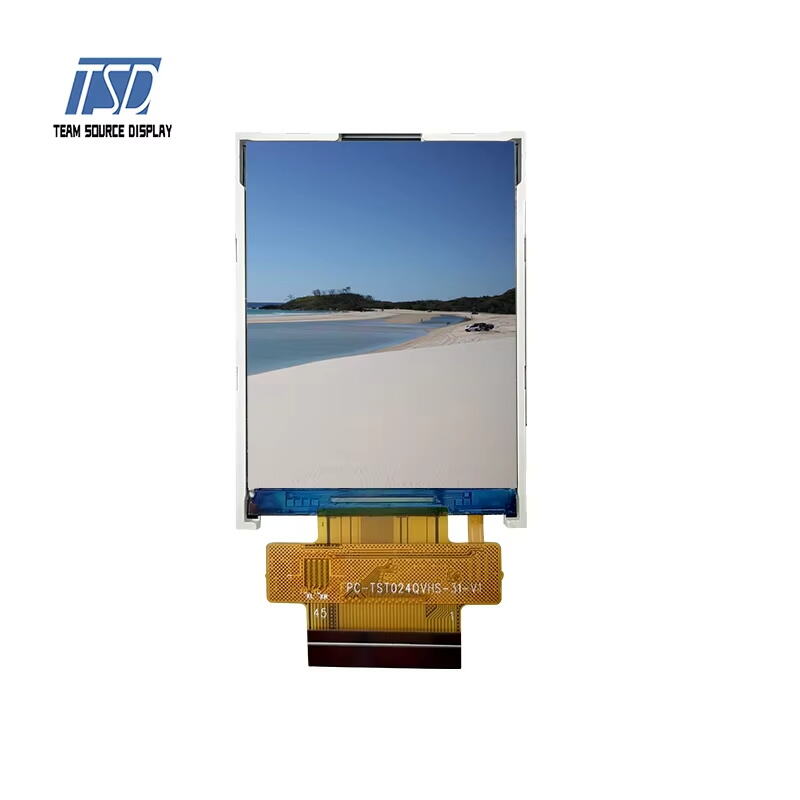מאפיינים עיקריים של מודולי LCD בגדלים בינוניים (3.5-10.1")
מפרט טכני לשימוש במגוון סצנות
מודולי LCD בגדלים בינוניים מגיעים עם דרגות שידור רבות בהתאם ליישום הנדרש. באופן נפוץ, אנו רואים תמיכה בפונקציונליות של 480p במסכים בסיסיים יותר, בעוד ש-720p מציעים איכות תמונה טובה יותר ו-1080p מספקים תצוגה באיכות HD מלאה. דגמים חדשים יותר מתחילים לתמוך גם ב-4K, מה שהופך אותם למתאימים לעבודות כמו מערכות עיצוב גרפי או מערכות 홈 סינמה שרוצות תמונות חדה במיוחד. עומק הצבעים הוא גם גורם חשוב כאן. הכוונה היא לכמות הביטים שכל פיקסל משתמש, בעיקרון. ככל שהמספר גבוה יותר, הצבעים על המסך נראים יותר אמינים - משהו שמדRICS ועוסקים בעיבוד וידאו מאוד מתחשבים בו בעבודתם. אחר כך יש את הבהירות שנמדדת בניטים, וזה קובע עד כמה המסך מצליח להציג את התוכן בתנאי תאורה שונים. עבור קיוסקים בפרצופו של הרחוב או שלטים דיגיטליים, דרגת בהירות גבוהה עוזרת להילחם בזיהרה של השמש כדי שבני אדם יוכלו לקרוא את התוכן המוצג מבלי לצמצם את עיניהם.
עמידות והתאמה לסביבה
מודולים בינוניים של מסכים_lcd צריכים להיות בעלי טווח חיים ארוך ולעמוד בסביבות קשות. רבים מהם כוללים דירוג IP שמסמן עד כמה הם עמידים בפני מים ואבק. בזכות זה הם הופכים לבחירה טובה להתקנת מסכים בחוץ או בפוקים שבהם שטף ולחות הם בעיה נפוצה. גם טווח הטמפרטורות הוא חשוב. רוב המסכים האלה פועלים בצורה תקינה בין מינוס 20 לפלוס 70 מעלות צלזיוס, מה שמכסה את רוב תנאי האקלים הנפוצים במדינות שונות. לכן הם ממשיכים לפעול בצורה תקינה גם בסופות קשות או בחום קיצוני. עמידות בפני מ удар היא חשובה באותה מידה, במיוחד במפעלים שבהם מכונות רועדות כל הזמן ועובדים עלולים להיתקע בציוד. חלק מהיצרנים מייצרים את ה-LCD שלהם מחומרים עמידים במיוחד למקרים כאלה. מפעלים שעובדים עם מכשור כבד או אתרים לבנייה מרוויחים מאוד מהעומס הזה, מכיוון שהמסכים שלהם לא נשברים בקלות במהלך תפעול רגיל.
יישומים רב-סצנתיים בתחומי התעשייה
תצוגות לרכב ותחבורה
מסכי LCD נמצאים כעת בכל מקום במכוניות, מגישים את דרכם למערכות ניווט, לוחי צלחות, וחיבורי בידור בכל רחבי הגלגל. הבהירות של תצוגות אלה באמת עושה הבדל עבור נהגים ונוסעים כאחד, אשר מעריכים להיות מסוגל לראות מידע בבירור ללא להילחץ את עיניהם. כשמדובר בציונים לתחום, לעבור את מבחן AEC-Q100 אומר שהמסכים האלה יכולים להתמודד עם כל מה שנזרק עליהם בתנאי נהיגה רגילים. תחשבו על איך מנועים חמים או על המפלים המתמשכים בכבישים קשים - מסך LCD באיכות טובה פשוט ממשיך לעבוד באופן אמין בכל זה. חברות התחבורה הציבורית גם התחילו לאמץ מודולים אלה עבור האוטובוסים והרכבות שלהם. מידע בזמן אמת על מסלולים ומאחרים מסייע לניהול לוח זמנים טוב יותר, מה שבסופו של דבר מוביל למספר פחות של תלונות מרוכבים הממתינים בתחנות ומתהים מתי הרכב שלהם באמת יגיע.
שילוב ציוד תעשייתי ורפואי
מכונות תעשייה תופסות רבות במודולי LCD לצורך פיקוח על תהליכים ובינוני משתמש, ונותנות לאופרטורים שליטה מדויקת על הפעולות תוך קבלת משוב בזמן אמת. כשמדובר בציוד רפואי, מסכים אלו הופכים להיות חיוניים לחלוטין, שכן הם מציגים תמונות באיכות גבוהה שמתאימות לדרישות ה-FDA ביחס לסטנדרטים לבטחון המטופל. לרופאים נדרשת ניקודת תצוגה כדי לבצע אבחנות מדויקות שמהוות את הבסיס לתכנון תוכניות טיפול מותאמות. גם רואים כיום שטכנולוגיית ה-LCD משתרשת אל תוך מכשירי בריאות ביתית. המסכים הללו מאפשרים לרופאים לפקח על מטופלים באופן מרחוק באמצעות מערכות מחוברות, כך שאנשים יכולים לקבל ייעוץ רפואי מבלי לעזוב את סלון הבית. התבוננות בכל יישומים אלה השונים בין תעשייה ומרפאות מראה עד כמה טכנולוגיית התצוגה הזו היא רב-תכליתית. יצרנים ממשיכים למצוא דרכים חדשות להטמעת LCDים, שכן הם פשוט עובדים טוב יותר מהחלופות הקיימות כשמדובר בדרישות של אמינות גבוהה.

אתגרי איזון הרזולוציה במודולי LCD
אסטרטגיות לאופטימיזציה של צפיפות הפיקסלים
כשזה מגיע למודולים LCD, מקבל צפיפות פיקסלים נכונה חשוב מאוד לאיכות התמונה ואיך משתמשים למעשה לראות דברים על מסכים שונים. יותר פיקסלים בכל אינץ' פירושו תמונות ברורות יותר ופרטים טובים יותר באופן כללי, משהו שעושה את כל ההבדל בטלפונים ובטלוויזיות HD. יצרנים משתמשים לעתים קרובות בתכסיסים כמו הגדרת תת-פיקסלים ו-Anti-aliasing כדי לגרום לתמונות להיראות טובות יותר גם כאשר הרזולוציה אינה גבוהה מאוד. טכניקות אלה בעצם לנקות את הקצוות המזדיינים ולהוסיף הגדרה נוספת כך תמונות לא נראות כל כך בלוק. להשיג את האיזון הנכון בין גודל המסך ודיוקן זה לא רק מתמטיקה. תחשבו על שעונים חכמים לעומת מסכי מחשבים גדולים, הם זקוקים לגישה שונה לחלוטין כדי להבטיח שהכל נראה טוב, בין אם אנחנו קוראים טקסט על פרק ידינו או צופים בסרטים על מסך גדול.
אלגוריתמי רזולוציה מתאימים
הטכנייקה להפוך רזולוציה שינתה את האופן בו פועלים מסכים, בעיקרון מאפשרת למסכים להתאים אוטומטית את הרזולוציה שלהם בהתאם למה שמוצג, כך שהדברים ירוצו חלק יותר ומשתמשים ייהנו למבט עליהם באמת. הערך האמיתי בא לידי ביטוי כשמטפלים בвизואליות משתנה כל הזמן, מה שקרוי כל הזמן במשחקים ובשירותי שידור וידאו. למידת מכונה הופכת את המערכות הללו אפילו טובות יותר עם הזמן בכך שהיא מגלמת מה המשתמשים אוהבים ומבצעת התאמות בНастройות הרזולוציה בהתאם. הסתכלו סביב - תראו את הטכנולוגיה הזו בכל מקום עכשיו, במיוחד בקונסולות משחק מודרניות ובאפליקציות פופולריות לשידור תוכן. כשצופים במשחקים דרמטיים או בשרשראות אחרונות, המסך פשוט כאילו יודע מתי להגביר או להוריד את הרזולוציה מבלי שאף אחד ישים לב. ומאחורי הקלעים, זה גם עוזר לחסוך באנרגיה, מונע מהתקנים לרוקן את הסוללה או להיתקע מניסיון להתמודד עם דברים שלא דורשים ביצועים מרביים.
כל היבט של איזון אתגרים בפתרונות מטופל באמצעות אסטרטגיות וטכנולוגיות חדשניות, תוך ודאות כי מודולי LCD מספקים חוויות ויזואליות יוצאות דופן.
הישגים טכנולוגיים בעיצוב מודולי LCD
שילוב מסך מגע לשימוש רב-תכליתי
הוספת מסכים מגעיות למודולי LCD פתחו כל מיני אפשרויות חדשות בתחומים רבים הודות למגוון טכנולוגיות המסכים המגעיות הזמינות. קחו לדוגמה מסכים בעלי עכבות - הם די נפוצים במחסנים ובמפעלים בגלל היכולת שלהם לעמוד במכות קשות ועדיין לעבוד גם כאשר מישהו לוחץ עליהם חזק. Meanwhile meanwhile הפכו לבחירה המועדפת לטלפונים, טאבלטים וכלי עבודה אחרים בהם דיוק באצבע חשוב מאוד, ובנוסף הם תומכים באותם ג'סט'רים מגע מרובים שעליהם התרגלנו כל כך. ואז יש טכנולוגיה אופטית שעובדת ממש טוב במסכים גדולים באתרי תעופה, תחנות רכבת או קניונים מאחר שהיא מתאימה להגדלה ללא אובדן בתפקודיות. עם זאת, בעת עיצוב מערכות אלו, יצרנים צריכים לחשוב גם על ארגונומיה, לוודא שהתגובה של המסך למגעים היא מדויקת וסידור הכפתורים, הסמלים והתפריטים נעשה בדרך ש giver משמעות לאנשים שמשתמשים בהם יום יום.
הטכנולוגיה של מסכי מגע ממשיכה לכבוש את כל תחומי החיים. לפי מחקר מסוים, שוק המסכים במגע העולמי צפוי לגדול ב-8.2 אחוזים בממוצע בכל שנה בין השנים 2021 ל-2026. אנו עדים לתהליך הזה מכיוון שעסקים בכל מיני תחומים מאמצים פנלים אינטראקטיביים. חנויות קמעונאות כבר מותקנות במסכים גדולים בהם הקונים יכולים לגלול בקטלוג המוצרים בעצמן. בתי ספר מחליפים לוחות מחיקים רגילים בפנלים חכמים אינטראקטיביים. גם במרפאות מותקנים מסכי מגע בתחנות הרשמה במקום טפסי נייר. השינויים האלה לא רק נותנים תחושת טכנולוגיה מתקדמת – הם גם עוזרים לאנשים לתקשר טוב יותר עם כל מערכת שהיא, ובאותו הזמן חוסכים זמן וכסף למעסקים המפעילים אותם.
פתרונות תאורה אחוריים חוסכים באנרגיה
השדרוגים שאנו רואים בטכנולוגיית הרקע של מסכי LCD הופכים את המסכים ליעילים בהרבה יותר בצריכת חשמל בימינו, במיוחד עם הופעת ה-LED וה-OLED. כבר רוב האנשים יודעים ש-LED חוסך אנרגיה בהשוואה לאפשרויות הישנות, אך ה-OLED מוציא לגמרי את הרכיב של תאורת רקע, מה שיכול להוריד משמעותית את חשבון החשמל. יש גם טכנולוגיה שנקראת כ dimming מקומי שמשנה את הבהירות של אזורים שונים במסך באופן עצמאי, מה שמאפשר תמונות איכותיות יותר עם שחור עמוק יותר וצריכת חשמל נמוכה יותר. חלק מהיצרנים טוענים שזה יכול להוריד את צריכת החשמל באלף scenarios עד לחצי.
השוואה בין תאורי אור קדומים לתאורי אור חכמים מבחינה אנרגטית מראה שיש הרבה כסף שניתן לחסוך. לדוגמה, תאורה פלואורסנטית הנמצאת בשימוש נרחב במסכים לעומת אלטרנטיבות של LED. המעבר מקטין את צריכה החשמל כמעט בחצי, לפי דוחות התעשייה, מה שפירושו שגם חברות וגם אנשים פרטיים משלמים פחות על חשבונות החשמל. ענף ה-LCD ממשיך לקדם את האפשרויות הירוקות כבר שנים, תוך ניסיון לשמור על קו שמאפשר לפתח מוצרים שפועלים היטב ולא פוגעים בסביבה בצורה חמורה מדי. חלק ממייצרי המוצרים כבר ראו שיפורים בפער הכספי ובה FOOTPRINT הפחמן בו זמנית.
מגמות עתידיות בפיתוח מסכים ממוצעים של LCD
התאמות מסך ממוחשבות באמצעות בינה מלאכותית
מסכי LCD בגודל בינוני הופכים חכמים יותר הודות לאינטליגנציה המלאכותית, ומשנים את המשחק כשמדובר בלהיות מסוגלים לענות על מה שהמשתמשים באמת רוצים מנסיון הצפייה שלהם. תצוגות אלה עכשיו אוספות מידע על איך אנשים מתקשרים איתן, ואז מותאמות דברים באופן אוטומטי כמו בהירות המסך או אפילו מראות סוגים שונים של תוכן בהתאם למה שמישהו מעדיף. התוצאה? חוויה כללית טובה יותר תוך שימוש בכוח פחות באותו הזמן. רוב האנשים בתעשייה חושבים שנראה הרבה יותר התפתחות בסוג הזה של תצוגות חכמות בתוך עשר שנים בערך. אנשים פשוט רוצים כל הזמן מכשירים שיבינו אותם טוב יותר ויגיבו ללא צורך בתערובת מתמדת.
חדשנות מסכים ניידים
מסכי LCD גמישים משנים את מה שאנחנו מצפים ממכשירים, במיוחד טלפונים ושעונים חכמים שכעת מתפתלים סביב האצבעות שלנו. הסיבה לכך שהדפוסים הנעולים האלה עובדים כל כך טוב היא בגלל דברים מדעי חומרים טובים יותר כמו אלקטרוניקה אורגנית וקרקעיות מיוחדות אנחנו כבר רואים כמה אפשרויות מעניינות מעבר לטכנולוגיה לצרכן בלבד. אדריכלים מנסים עם פאנלים מעוקבים שמקיפים את חזית הבניין, ויוצרים חוויות חזותיות דינמיות עבור עוברים. יצרני מכוניות בוחנים לוח מכשירים גמיש שמתאים לעצמי הנהג. בעוד שיש עדיין הרבה מקום לשיפור, מומחים רבים מאמינים טכנולוגיית LCD גמישה תשנה את הדרך שבה אנו מתקשרים עם מידע דיגיטלי בחיי היומיום.
בחירת מודול LCD האידיאלי עבור הצרכים שלך
تقييم תאימות סביבתית
מידת ההתאמה של מודול מסך LCD לסביבתו משפיעה רבות על אורך החיים שלו ועל ביצועים תקינים. בחינה של המקומות שבהם מודולים אלו פועלים בפועל מחייבת הקפדה על גורמים כמו רטوبة באוויר, שינויי טמפרטורה לאורך הזמן, והאם הם עלולים להתחבר עם כימיקלים שונים במהלך הפעלה רגילה. בחינה מקצועית של כל אותם גורמים סביבתיים מאפשרת לנו לסמוך על הבחירה שלנו ב-LCD מסויים, ולהבטיח שהוא יתמודד עם כל אתגר בסביבה שלו, ויבצע ביעילות מקסימלית. קיימות גם דוגמאות לסטנדרטים בתעשייה, כמו התקנות RoHS ו-WEEE, שמספקות הנחיות ברורות למהות הידружות סביבתית בייצור אלקטרוניקה. הנחיות אלו עוזרות גם לחברות המייצרות וגם לצרכנים להבין אילו תעודות ירוקות חשובות באמת במונחי בטחה וקיימות. רוב המהנדסים שאני מכיר נוטים להכין רשימות בדיקה פשוטות כשקונים מודולי LCD חדשים. הרשימה כוללת לרוב אימות של סימני התאמה חשובים, ואז בדיקה האם המפרט טכני תואם את הדרישות הספציפיות של השימוש במציאות. השיטה הזו מקצרת את הזמן המבוזבש בחיפושים מיותרים, ומגיעה מהר יותר לפתרון שעובד באמת למשימה הנדרשת.
ניתוח עלויות לעומת ביצועים
להשיג את האיזון הנכון בין מה שמעלה משהו ואיך הוא פועל חשוב מאוד כאשר משקיעים במודולים LCD. כאשר מסתכלים על מחיר הבעלות הכולל, אנשים צריכים לחשוב לא רק על מה שהם משלמים מראש אלא גם על דברים כמו כמה זמן המודול מחזיק מעמד ואיך יעיל הוא פועל. מודולים LCD בעלי ביצועים טובים יותר בדרך כלל מגיעים עם תגיות מחיר גדולות יותר בהתחלה, אך אלה נוטים לחסוך כסף לאורך זמן מכיוון שהם נמשכים יותר ולא נשברים לעתים קרובות. אנשי מקצוע בתחום מציעים להשתמש במספרים אמיתיים ממחקרים מקרים במקום רק לנחש בעת הערכת אפשרויות. הם מסתכלים על מה שצריך להוציא עכשיו לעומת מה שאולי ישמר מאוחר יותר. בחירה חכמה לגבי המודול המתאים ביותר תלויה בביצוע סוג זה של ניתוח שחשב גם בהשפעה על הארנק וגם בתוצאות הביצועים עבור כל יישום הנדרש.
שאלות נפוצות
אילו רזולוציות נפוצות נתמכות על ידי מודולי LCD בממוצע?
מודולי LCD בממוצע לרוב נתמכים רזולוציות כמו 480p, 720p, 1080p, ואף חלקן מציעות אפשרויות של 4K.
כמה חשובה עומק צבע במודולי LCD?
עומק הצבע הוא קריטי לייצוג צבעים מדויק, במיוחד ביישומים הדורשים דיוק בצבע.
האם ניתן להשתמש במודולים אלו LCD בחוץ?
כן, לחלק מהמודולים הבינוניים של מסכים LCD יש בהירות גבוהה ודרגת הגנה IP המותאמת לשימוש חיצוני.
למה רמת הפיקסלים חשובה למסכי LCD?
ריכוז פיקסלים גבוה יותר יוצר תמונות חדות וдетאלים מדויקים יותר, מה שמשפר את איכות התמונה הכללית.
איך אלגוריתמי רזולוציה מתאימים תורמים למודולי LCD?
אלגוריתמי רזולוציה מתאימים משפרים את איכות התצוגה על ידי התאמת הרזולוציה של המסך באופן דינמי בהתאם לתוכן, מה שמבטיח יעילות ו שביעות רצון למשתמש.




